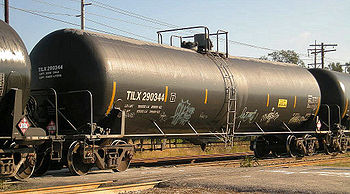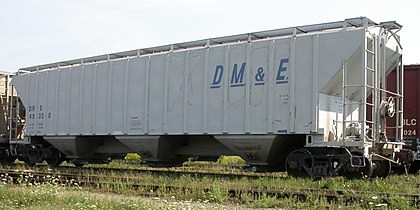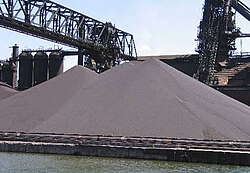Bulk cargo
This article includes a list of general references, but it remains largely unverified because it lacks sufficient corresponding inline citations. (April 2010) |


Bulk cargo is commodity cargo that is transported unpackaged in large quantities.
Description[]
This section does not cite any sources. (March 2021) |
It refers to material in either liquid or granular, particulate form, as a mass of relatively small solids, such as petroleum/crude oil, grain, coal, or gravel. This cargo is usually dropped or poured, with a spout or shovel bucket, into a bulk carrier ship's hold, railroad car/railway wagon, or tanker truck/trailer/semi-trailer body. Smaller quantities (still considered "bulk") can be boxed (or drummed) and palletised. Bulk cargo is classified as liquid or dry.
The Baltic Exchange is based in London and provides a range of indices benchmarking the cost of moving bulk commodities, dry and wet, along popular routes around the seas. Some of these indices are also used to settle Freight Futures, known as FFA's. The most famous of the Baltic indices is the Baltic Dry Indices, commonly called the BDI. This is a derived function of the Baltic Capesize index (BCI), Baltic Panamax index (BPI), Baltic Supramax index (BSI) and the Baltic Handysize index (BHSI). The BDI has been used as a bellwether for the global economy as it can be interpreted as an indicator of an increase or decrease in the amount of raw commodities countries are importing/exporting.
Dry bulk[]
Dry bulk refers to any cargo which is carried in bulk in solid form. Such carriage is often referred to as the "dry" trades.[1] They would include:
- Bauxite
- Bulk minerals (sand & gravel, copper, limestone, salt, etc.)
- Cements
- Chemicals (fertilizer, plastic granules & pellets, resin powder, synthetic fiber, etc.)
- Coals and cokes
- Agricultural products such as dry edibles (for animals or humans: alfalfa pellets, citrus pellets, livestock feed, flour, peanuts, raw or refined sugar, seeds, starches, etc.)
- Grains (wheat, maize, rice, barley, oats, rye, sorghum, soybeans, etc.)
- Iron (ferrous & non-ferrous ores, ferroalloys, pig iron, scrap metal, pelletized taconite), etc.
- Wood chips
Liquid bulk cargo[]
Liquid bulk cargo includes any cargo carried in closed tanks and poured or pumped into the carrying vessel. This would include:
- Hazardous chemicals in liquid form
- Petroleum
- Gasoline
- Liquefied natural gas (LNG)
- Liquid nitrogen
- Cooking oil
- Fruit juices
- Rubber
- Vegetable oil
Gallery[]
A milk tank car for bulk loading.

DME 49328, a covered hopper owned and operated by the Dakota, Minnesota and Eastern Railroad

Bulk loading of a feeder ship with rapeseed meal

Large ports specializing in bulk cargo[]
See also[]
- Bulk material handling
- Covered hopper
- Flexible intermediate bulk container (bigbag)
- Harmonized System
- Hopper car
- Lake freighter
- Loading gauge
- Maritime transport
- Milk tank car
- Neo-bulk cargo
- Rotary car dumper
- Selfdischarger
- Tank car
- Tank truck
- World's busiest port
Bibliography[]
- Bliault, Charles; Jonas, Martin; The North of England P&I Association (2016). Bulk Cargoes: A Guide to Good Practice (First ed.). UK: The North of England P&I Association. p. 280. ISBN 978-0-9574936-3-6. ASIN 0957493630.
- George, William (2005). Stability and Trim for the Ship's Officer. Centreville, MD: Cornell Maritime Press. ISBN 978-0-87033-564-8.
- Hayler, William B.; Keever, John M. (2003). American Merchant Seaman's Manual. Cornell Maritime Pr. ISBN 0-87033-549-9.
- United Nations Conference on Trade and Development (UNCTAD) (2006). Review of Maritime Transport, 2006 (PDF). New York and Geneva: United Nations. Archived from the original (PDF) on 2011-07-28. Retrieved 2008-12-04.
- United Nations Conference on Trade and Development (UNCTAD) (2007). Review of Maritime Transport, 2007 (PDF). New York and Geneva: United Nations.
References[]
- ^ Dry Cargo Chartering. London: Institute of Chartered Shipbrokers. 2013. p. 38.
- Bulk material handling





